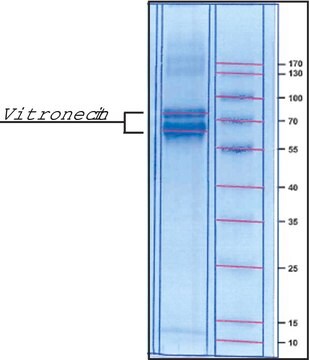추천 제품
제품명
Fibronectin solution human fibroblasts, cell culture derived, ~0.5 mg/mL, sterile-filtered, BioReagent, suitable for cell culture
생물학적 소스
human fibroblasts
Quality Level
무균
sterile-filtered
제품 라인
BioReagent
양식
solution
분자량
31 kDa
포장
pkg of 100 μL
농도
~0.5 mg/mL
기술
cell culture | mammalian: suitable
불순물
HBSAG, none detected
HCV, none detected
HIV-1/HIV-2, none detected
NCBI 수납 번호
UniProt 수납 번호
결합 특이성
Peptide Source: Collagen
배송 상태
dry ice
저장 온도
−20°C
유전자 정보
human ... FN1(2335)
유사한 제품을 찾으십니까? 방문 제품 비교 안내
일반 설명
애플리케이션
- It is used in purification of human extracellular matrix (ECM)
- Coating of tissue culture plates with extracellular matrix components
- Used during cell culture (For xeno-free, feeder-free culture the cells were passaged in to human fibronectin along with other components)
Fibronectin from human plasma can be used with epithelial cells, mesenchymal cells, neuronal cells, fibroblasts, neural crest cells, and endothelial cells. It is recommended for use as a cell culture substratum at 1-5 μg/cm2 or 0.5-50 μg/mL. The optimal concentration does depend on cell type as well as the application and research objectives.
생화학적/생리학적 작용
성분
주의사항
제조 메모
Storage Class Code
11 - Combustible Solids
WGK
WGK 3
Flash Point (°F)
Not applicable
Flash Point (°C)
Not applicable
개인 보호 장비
Eyeshields, Gloves, type N95 (US)
이미 열람한 고객
문서
Extracellular matrix proteins such as laminin, collagen, and fibronectin can be used as cell attachment substrates in cell culture.
프로토콜
Dilute fibronectin to the desired concentration. Optimum conditions for attachment are dependent on cell type and application. The typical coating concentration is 1 – 5 ug/cm2.Fibronectin coating protocol, products, and FAQs.
자사의 과학자팀은 생명 과학, 재료 과학, 화학 합성, 크로마토그래피, 분석 및 기타 많은 영역을 포함한 모든 과학 분야에 경험이 있습니다..
고객지원팀으로 연락바랍니다.








